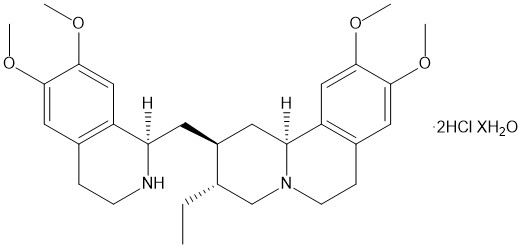Emetine hydrochloride | Protein synthesis inhibitor
NMR (Conforms)

Available Options
| Size: | Price | Quantity | |
|---|---|---|---|
| 50 mg | $90.00 | ||
| 250 mg | $340.00 |
Emetine hydrochloride (316-42-7) is one of the active ingredients of ipecac root extract, used as an emetic.1 Induces apoptosis in breast cancer cells via inhibition of Wnt/β-catenin signaling.2 Inhibits Zika and Ebola virus in vitro and in vivo, targeting viral entry and replication by inhibiting viral RNA polymerase and host lysosomal function.3 Also inhibits SARS-CoV-2 replication in cells (EC50 for viral load reduction is 0.46 μM).4 A useful agent for inhibiting protein synthesis in eukaryotic cells by virtue of its inhibition of the ribosome 40S subunit.5
References/Citations:
1) Lee et al. (2008), Ipecacuanha: the South American vomiting root; J R Coll. Physicians Edinb., 38 355
2) Sun et al. (2019), Emetine Exhibits Anticancer Activity in Breast Cancer Cells as an Antagonist of Wnt/β-catenin Signaling; Oncol. Rep., 42 1735
3) Yang et al. (2018), Changing cancer survival in China during 2003-2015: a pooled analysis of 17 population-based cancer registries; Cell Discov., 4 31
4) Choy et al. (2020), Remdesivir, Lopinavir, and Homoharringtonine Inhibit SARS-CoV-2 Replication in Vitro; Antivir. Res., 178 104786
5) Cuyas et al. (2015), Anti-protozoal and Anti-Bacterial Antibiotics That Inhibit Protein Synthesis Kill Cancer Subtypes Enriched for Stem Cell-Like Properties; Cell Cycle, 14 3527
NMR (Conforms)
Safety Data Sheet:
Product Data Sheet:
Materials provided by Focus Biomolecules are for laboratory research use only and are not intended for human or veterinary applications. Please note that we do not sell to individuals and that all orders placed by non-research organizations will incur a $20 restocking/refund fee
Emetine hydrochloride (316-42-7) is one of the active ingredients of ipecac root extract, used as an emetic.1 Induces apoptosis in breast cancer cells via inhibition of Wnt/β-catenin signaling.2 Inhibits Zika and Ebola virus in vitro and in vivo, targeting viral entry and replication by inhibiting viral RNA polymerase and host lysosomal function.3 Also inhibits SARS-CoV-2 replication in cells (EC50 for viral load reduction is 0.46 μM).4 A useful agent for inhibiting protein synthesis in eukaryotic cells by virtue of its inhibition of the ribosome 40S subunit.5
References/Citations:
1) Lee et al. (2008), Ipecacuanha: the South American vomiting root; J R Coll. Physicians Edinb., 38 355
2) Sun et al. (2019), Emetine Exhibits Anticancer Activity in Breast Cancer Cells as an Antagonist of Wnt/β-catenin Signaling; Oncol. Rep., 42 1735
3) Yang et al. (2018), Changing cancer survival in China during 2003-2015: a pooled analysis of 17 population-based cancer registries; Cell Discov., 4 31
4) Choy et al. (2020), Remdesivir, Lopinavir, and Homoharringtonine Inhibit SARS-CoV-2 Replication in Vitro; Antivir. Res., 178 104786
5) Cuyas et al. (2015), Anti-protozoal and Anti-Bacterial Antibiotics That Inhibit Protein Synthesis Kill Cancer Subtypes Enriched for Stem Cell-Like Properties; Cell Cycle, 14 3527
Calculate the molar concentration, mass or volume in a solution.
Concentration × Volume × Molecular Weight = Mass
Focus Biomolecules • Plymouth Meeting, PA USA • 1-855-FOCUS21
Focus Biomolecules
Plymouth Meeting, PA USA
1-855-FOCUS21
Website Created by Advanta Advertising LLC.

